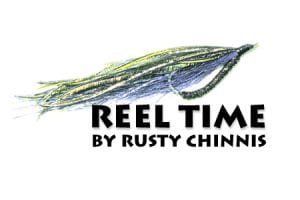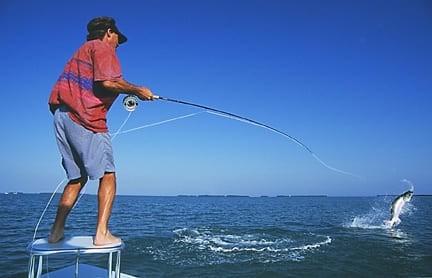The weather hasn’t cooperated in a long time but as soon as it does, I’ll be out hunting tarpon. It’s a little early for the migration but while I’m waiting for the weather to change, I’ll be planning for the season. The boat is getting cleaned up, I just got the trolling motor tuned up and the outboard serviced. I’m rerigging my spin and fly tackle and tying flies in anticipation of one of my favorite times of the year. Tarpon are one of the premier gamefish that swim local waters and a noble adversary on any tackle. The migration gets into full swing during the month of May and generally runs into August and September for die-hard anglers. These fish are a test of any angler and tackle, running to over 200 pounds. The average runs an astounding 80 to 100 pounds.
We are blessed with some of the best tarpon fishing in the world and the local bars and inshore waters host some of the finest fly and spin fishing to be found anywhere. This isn’t a game of numbers and to the anglers who pursue tarpon it’s the hunt and the action that keep them on the bow for six to eight hours in the hot summer sun.
Tackle should match the size of the quarry and most anglers opt for a 20- to 30-pound spin outfit and 11 to 12 weight fly rod, line and reel. A heavy bite tippet is required because of the size of tarpon and their rasp-like mouth. Fly anglers generally use a 60- to 80-pound tippet while spin anglers choose 80- to 100-pound test. While it might seem like a difficult task to land a tarpon on the fly, or any tackle for that matter, anglers who knows the limits of their tackle can actually land a tarpon in a surprisingly short time. The key is to apply maximum pressure from the hookup never letting up. Neophyte anglers have a tendency to “baby” their tarpon in a misguided attempt to land them. The truth is that the longer you fight a tarpon the better chance you have of losing it.
A properly (IGFA approved) tied tarpon leader used by fly fishers usually runs between 10 and 12 feet and is tapered to properly deliver the fly. The leader includes a class tippet (weakest link) from 16 to 20 pounds that is doubled at both ends to soften the (shock) impact to the class tippet and bite tippet. Key to the whole equation is to have a very sharp hook as tarpon have extremely tough mouths. Conventional leaders vary from angler to angler, but a doubled standing line tied to a leader and then to the bite tippet with a blood knot or Albright Special is recommended.
Flies vary from the classic splayed feather “Keys” style to more complex designs like the “Toad,” and various baitfish imitations. Some fly anglers are not concerned with actually landing a tarpon, preferring to just enjoy the hunt, the hook up and the jumps that usually follow the hook set. They use light bite tippets which allow the tarpon to work through the leader with their abrasive mouths. The key to landing tarpon on the fly is accuracy. The fly must be placed perfectly, move in a precise direction relative to the fish and be at the proper (fishes’) depth. Even when all of these factors come together, there’s still about a 50% chance that the tarpon will reject the fly.
The go-to bait for spin anglers is a live crab. Small blue crabs can be purchased from bait shops and pass crabs can be dipped from the local passes on a falling tide. Other effective baits include pinfish, threadfin herring and pilchards. Artificial lures like the DOA Bait Buster and the 4- and 6-inch shrimp, jigs and even top water plugs can be effective. Patience is a critical factor when fishing for tarpon, especially when fly fishing. The most successful anglers find the edge of a sand bar or other underwater feature that tarpon track, anchor in casting range and wait. Sometimes tarpon come at a steady rate but just as often there are long periods of time when the only thing to look at is the water. This really separates the good anglers from the great anglers. There are times when you need to move but knowing when and where is a skill that is developed and never mastered.
Once set up, the angler must be able to make a 40- to 50-foot cast to a location the size of a dinner plate. Placement of the fly cannot be overemphasized, because tarpon will seldom vary a foot or two from their path to eat a fly. Although there is always the rare exception, a fly must never travel in a path towards the intended target. A tarpon’s prey species wouldn’t survive long if it moved towards its aggressor, and tarpon know it. Besides moving away from the fish, the fly must move at the proper pace, be at the proper depth and never slow down when a tarpon is tracking it. Conversely you can’t move the fly too fast, taking it out of a tarpon’s range. If all this wasn’t demanding enough, once a tarpon decides to eat the fly an angler’s mettle is really tested.
Conventional anglers usually look for rolling fish in the near-shore Gulf and motor well ahead of them to intercept their path. Trolling motors can be effective for following a school in deep water but will spook them in the shallows. One thing that all tarpon anglers should practice is courtesy. Often a boat has been working long and hard to get properly set up for a shot and a boat running up on the fish will spoil the day for everyone. Tarpon are not trout and attempting to raise the rod to set the hook is a cardinal mistake. Fortunately, once a tarpon decides to eat there’s no need to make a lightning-fast hook set. When fly fishing, the right set is called a “strip strike,” which involves letting the line come tight and immediately setting the hook with a combination of the line hand and the rod. Conventional anglers should also have the patience to let the line come tight before attempting to hook the fish. Then the angler must at once work to set the hook in the cement-like jaw while being ready for the fish to bolt away from the boat.
After a fly angler’s initial hook set, attention must go immediately to clearing (getting the loose line off the deck) the line. In most cases the angler has been stripping in line when the fish bites and the hook is set. That line can easily foul on the angler, the rod or the reel. The protocol is to take your attention from the fish to the line at your feet. Hold the rod away from your body and let the excess line pass through your stripping hand in a circle made with the thumb and the forefinger. Once the line is “on the reel” set the hook with several more strip strikes, using the rod. Conventional anglers often use circle hooks which don’t require a hook set. They just need to let the line come tight and enjoy the action. In any case, a tarpon cannot be aware of the angler on the other end until the hook set.
While it’s important to exert maximum pressure on the tarpon during the fight, anglers must yield on jumps. On the jump the standard maneuver is to thrust the rod forward to relieve pressure on the line. This prevents the tarpon from breaking off if it lands on a taught line. This maneuver is known as “bowing to the king.”
It’s customary to start the engine and get as close to the tarpon as possible after the initial and subsequent long runs. This allows the angler to apply maximum pressure. If a tarpon is a hundred yards from the boat, the stretch of the line makes it impossible to apply any real pressure.
If you’re looking for a good jump shot here’s a great tip. When a tarpon makes any long run, motor close to it, applying only enough pressure to make sure the hook doesn’t dislodge. As soon as you are in place, frame the shot you want and then have the angler apply maximum pressure. Most times the tarpon will make a jump that’s close enough to the boat to get the angler and the fish in the shot. It’s not a sure thing, but when it works it can present an awesome photographic opportunity. Finally, don’t try and rush the tarpon when it gets near the end of the fight. Keep the pressure on but don’t clamp down and try to force the fish to the boat. In the end it’s a game of odds. Every time I think I’ve discerned a pattern, the tarpon teach me a new lesson! Good action can be found right through July and beyond for fly anglers while the best month for conventional anglers is generally June. Tarpon fishing is a challenging endeavor, but it’s well worth the effort when you finally get that first scale-rattling jump.
Now repeat after me, “I’ll remember all this, learn it and reread so I don’t make any mistakes.” Good luck with that, but I guarantee you those are some of the most exciting mistakes you’ll ever make.
































